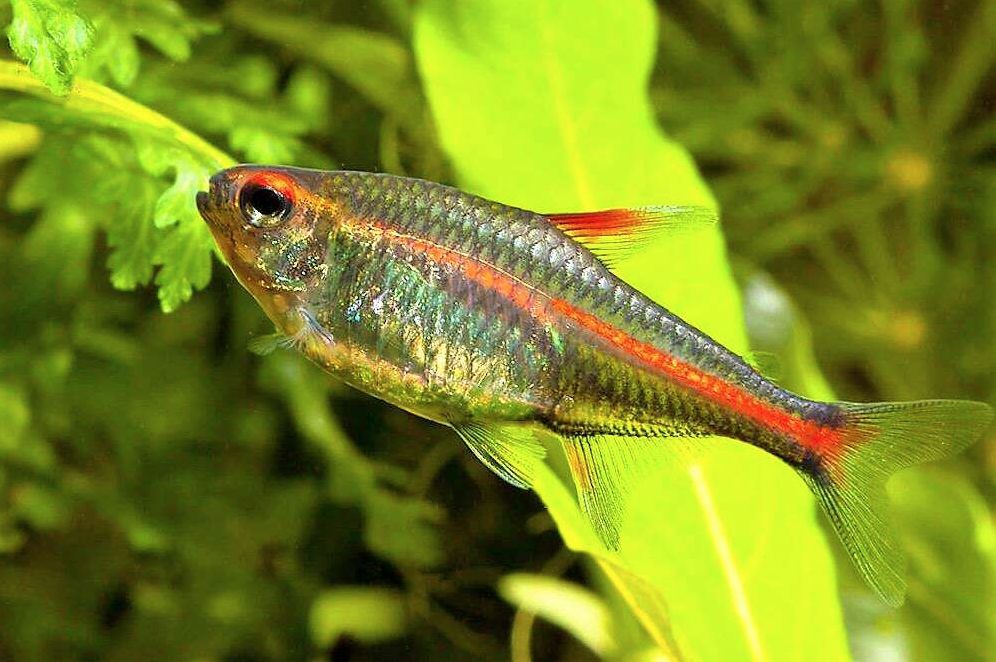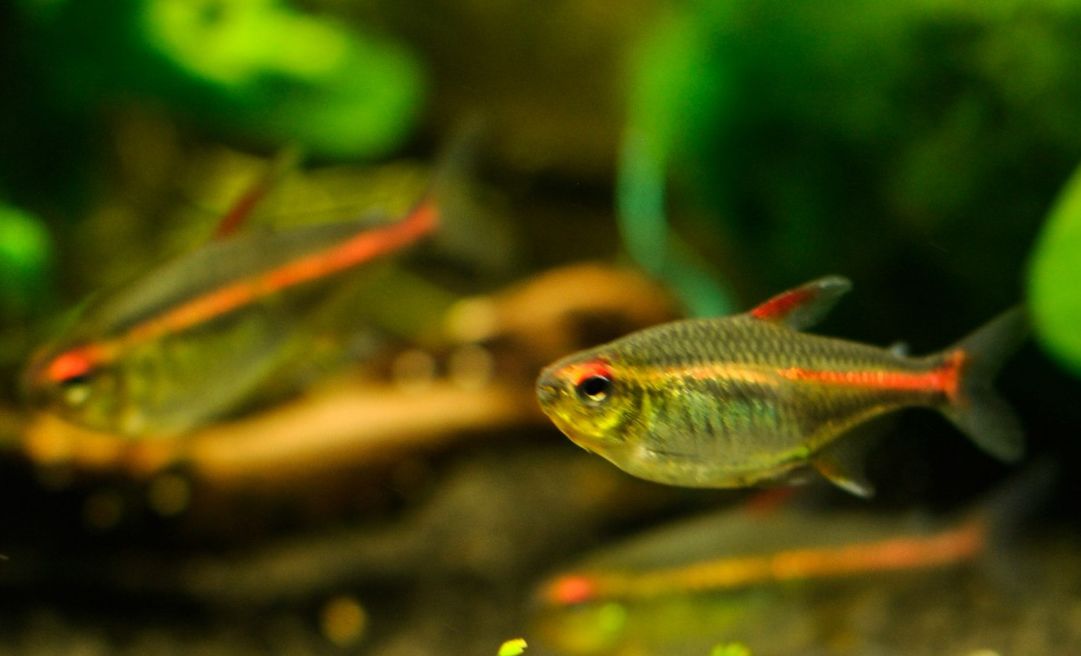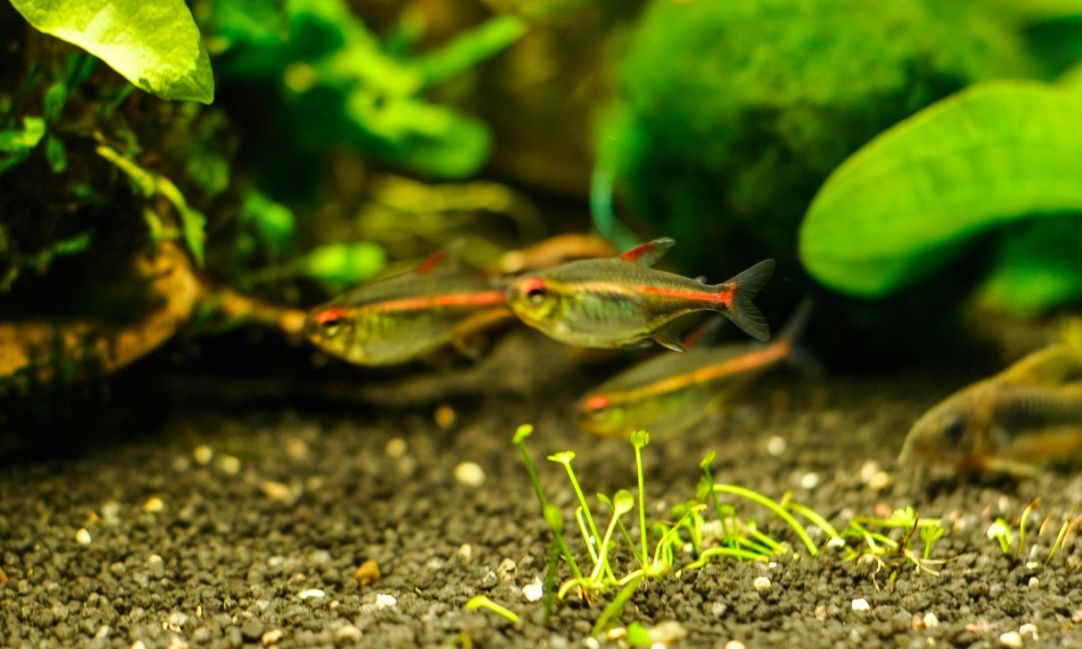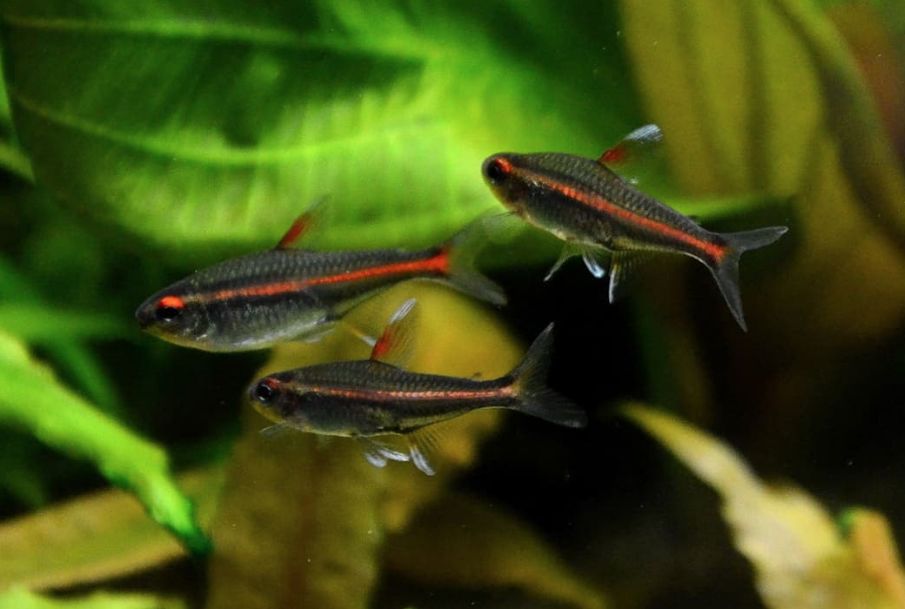Glowlight tetras are captivating members of the tetra family, renowned for their striking glowing stripe that runs along their bodies. This vibrant feature makes them a popular choice among aquarists of all skill levels, as a well-kept school can create a mesmerizing display in any aquarium. As they mature, the colors of glowlight tetras become more saturated, enhancing their beauty and appeal even further. To provide an ideal environment for these fish, consider keeping them in a well-planted tank with soft, diffused lighting, which can accentuate their luminous qualities. Additionally, they thrive in schools, so housing them with compatible species like rasboras or other small tetras can lead to a lively and dynamic community tank.

Contents
Habitat in the wild
Glowlight tetras inhabit the tropical rainforests of South America, primarily in the Amazon River basin, including countries like Guyana and Suriname. These fish prefer small, slow-moving rivers and streams with soft, turfy bottoms covered in decaying leaves and other plant debris. Their natural habitat is characterized by the following features:
The water in these environments often has a brownish hue due to high levels of humic acids produced from the decomposition of vegetation. These acids not only give the water its unique color but also reduce transparency, creating a dimly lit environment. Since sunlight struggles to penetrate the dense canopy overhead, these waters are perpetually in twilight.
Typically, the water temperature ranges from 24 to 28°C, providing comfortable living conditions for the fish. It’s important to note that these blackwater habitats are nearly devoid of bacteria, resulting in an almost aseptic environment. This phenomenon is associated with the low levels of calcium and water hardness (gH 1–3, KH 0–0.1), which significantly influence the health of the fish and their offspring.
Glowlight tetras are well adapted to these conditions; their eggs and larvae cannot tolerate bright light, which helps protect them from predators during their early life stages. Therefore, to successfully keep glowlight tetras in an aquarium, it is essential to replicate their natural environment by using soft lighting and creating hiding places with live plants and decorations. This approach will help ensure their comfort, health, and breeding success.

Description
Body Shape and Features
Glowlight tetras possess a slender, elongated body that is perfectly adapted for agile movement in the water. Their streamlined shape allows them to navigate through their aquatic environment with ease. They feature relatively large, round eyes that are typically black, providing a striking contrast against their vibrant coloration. These prominent eyes not only enhance their overall appearance but also contribute to their ability to spot potential threats in their surroundings.
Vibrant Coloration
The most captivating characteristic of the glowlight tetra is its vivid coloration. The base color of their body is silvery or translucent, creating a shimmering effect as they swim. The defining feature is the horizontal stripe that extends from the head to the base of the tail. This stripe is usually a bright red or orange, which is where the name “Glowlight Tetra” originates. Under the right lighting conditions, this stripe appears to glow, making the fish even more visually striking.
Comparison with Black Neon Tetras
While glowlight tetras share some similarities with black neon tetras, particularly the glowing stripe, they are distinct species. The black neon tetra has a darker body coloration, predominantly black, whereas glowlight tetras have a translucent body that highlights their vibrant stripe. This key difference makes it easy for aquarists to differentiate between the two species.
Size
Glowlight tetras are considered a small and slender species within the tetra family. On average, they grow to about 1.5 to 2 inches (3.8 to 5 centimeters) in length. Individual growth may vary slightly based on factors such as diet and environmental conditions, but they generally remain within this size range throughout their lives. Their compact size makes them an excellent choice for smaller aquarium setups and allows enthusiasts to maintain a small school of these colorful fish.
Lifespan
Under optimal care and conditions, glowlight tetras typically have an average lifespan of about 3 to 5 years. However, individual variations can occur, with some fish living shorter or longer lives depending on their environment, diet, and overall health. Proper care, including maintaining clean water and a balanced diet, can help maximize their lifespan and enhance their vibrant colors.
| Characteristic | Description |
|---|---|
| Scientific Name | Hemigrammus erythrozonus |
| Common Name | Glowlight Tetra |
| Family | Characidae |
| Origin | South America, Amazon River basin |
| Size | 1.5 to 2 inches (3.8 to 5 centimeters) |
| Lifespan | 3 to 5 years |
| Temperament | Peaceful, social, schooling fish |
| Water Temperature | 75°F to 82°F (24°C to 28°C) |
| Water pH | 6.0 to 7.5 |
| Water Hardness | 2 to 10 dGH |
| Tank Size | Minimum 10 gallons, larger tank preferred |
| Diet | Omnivorous, prefers small live and frozen foods |
| Behavior | Active, shoaling/swimming in groups |
| Compatibility | Peaceful, compatible with other small fish |
| Tank Setup | Soft, slightly acidic water; plants, driftwood |
| Lighting | Moderate to subdued lighting |
| Breeding | Egg scatterer, requires separate breeding tank |
| Special Considerations | Sensitive to poor water quality, requires clean water |

Difficulties in keeping
If a tank is well-balanced and properly set up, keeping glowlight tetras can be a rewarding experience, even for beginners. These fish are ideal for those looking to embark on their first aquarium journey. With their peaceful nature and vibrant colors, glowlight tetras not only add beauty to a community tank but also adapt well to a range of water conditions.
Care and keeping in a tank
Tank size
Glowlight tetras thrive best when kept in a school of 6 to 10 individuals, as this social behavior helps reduce stress and encourages natural interactions. The minimum recommended tank size for a school of these fish is 10 gallons; however, opting for a larger tank is always advisable. A bigger aquarium not only provides a more stable environment but also enhances the overall quality of life for the fish.
With a larger tank, aquarists can maintain better water quality and minimize fluctuations in parameters, which is crucial for the health of glowlight tetras. Additionally, a spacious tank allows for more diverse aquascaping options, including the incorporation of live plants, driftwood, and hiding spots. These features not only create a visually appealing habitat but also promote the well-being and comfort of the fish.
In summary, while a 10-gallon tank can accommodate a small school of glowlight tetras, providing a larger tank—such as a 20-gallon or more—will significantly enhance swimming space and overall tank stability, ultimately contributing to the health and happiness of your glowlight tetras.
Water parameters
Glowlight tetras are relatively undemanding when it comes to tank conditions, provided that the environment remains reasonable and stable. They prefer soft and slightly acidic water, but fish sold in local stores have typically adapted to the water conditions in your area.
Ideal Water Parameters
Temperature: The ideal temperature range for glowlight tetras is between 75°F and 82°F (24°C to 28°C). Maintaining this temperature will ensure the fish are comfortable and active.
pH Level: These tetras thrive in slightly acidic to neutral water conditions. The recommended pH range is typically between 6.0 and 7.5. It’s crucial to avoid extreme fluctuations in pH, as they can cause stress to the fish.
Water Hardness: Glowlight tetras prefer soft to moderately hard water. The recommended range for water hardness (GH) is around 2 to 10 degrees, with a preference for the lower end of this spectrum to mimic their natural habitat.
Water Quality
Ammonia, Nitrite, and Nitrate Levels: Maintaining water purity is paramount. Ammonia and nitrite levels should ideally be undetectable, while nitrate levels should be kept below 20-30 ppm. Regular partial water changes—ideally once a week—are essential for achieving this, along with a good filtration system.
Filtration and Water Movement: A reliable filtration system is vital for maintaining water quality and providing gentle water movement. Glowlight tetras come from environments with slow-moving or stagnant waters, so a gentle flow is preferable to ensure their comfort.
Acclimation
When introducing glowlight tetras to a new aquarium or during water changes, proper acclimation is crucial to prevent temperature and pH shock. Gradually acclimate them using a slow drip method or the floating bag method. This allows them to adjust to the new water conditions over time, reducing the risk of stress and ensuring a smooth transition.
Tank decor
Creating a natural biotope for glowlight tetras can greatly enhance their comfort and overall well-being. A suitable setup would feature dark sand or fine gravel as the substrate, which not only mimics their natural environment but also provides a visually appealing contrast to the fish’s vibrant coloration.
Incorporate driftwood and small rocks as tank decorations to replicate the submerged structures found in their native habitats. These elements not only provide hiding spots and territorial boundaries but also contribute to the aesthetic of the aquarium.
Adding dried leaves to the bottom can help create a slightly acidic environment, lending the water a gentle brown tint reminiscent of the blackwater rivers where glowlight tetras are found. This not only enriches the biotope but also enhances the overall health of the fish by releasing beneficial tannins into the water.
It’s important to note that natural habitats of glowlight tetras don’t typically feature dense plant growth. Therefore, a sparsely planted tank is sufficient. You might consider using low-growing plants or floating varieties to provide cover without overwhelming the space, ensuring the fish feel secure while still having ample swimming room. By creating this type of environment, you’ll help your glowlight tetras thrive and exhibit their natural behaviors.
Diet
Glowlight tetras are omnivorous and will eagerly consume a variety of foods, making them easy to feed in a home aquarium. They thrive on all types of live, frozen, and artificial feed, including flakes and granules. However, it’s essential to ensure that the food is small enough for them to swallow easily.
Feeding small portions 2-3 times a day is recommended, as glowlight tetras are less likely to eat food that sinks to the bottom of the tank. Regular feeding helps maintain their vibrant colors and overall health.
To keep glowlight tetras in optimal condition, it’s beneficial to incorporate live and frozen foods into their diet. Options such as bloodworms, brine shrimp, and water fleas are excellent choices. These protein-rich foods not only promote healthy growth but also enhance their coloration. Additionally, you can supplement their diet with high-quality artificial foods to provide a well-rounded nutritional profile. By offering a diverse diet, you’ll help your glowlight tetras thrive and exhibit their natural beauty.

Tank mates
Is one of the most peaceful among all tetra species. It is an active and quite colorful fish. Compatibility is quite high with the species of the same size. Although this is a schooling fish, usually it doesn’t swim in a school with other fishes. However, larger fishes such as cichlids aren’t safe tank mates, since they’ll consider the glowlight tetra as feed.
When selecting tank mates for glowlight tetras, it’s important to consider compatible species that share similar water parameter requirements and temperaments. Here are some suitable tank mates for glowlight tetras:
- Harlequin Rasboras (Trigonostigma heteromorpha)
- Neon Tetras (Paracheirodon innesi)
- Ember Tetras (Hyphessobrycon amandae)
- Black Neon Tetras (Hyphessobrycon herbertaxelrodi)
- Cardinal Tetras (Paracheirodon axelrodi)
- Rummy Nose Tetras (Hemigrammus rhodostomus)
- Dwarf Gouramis (Trichogaster lalius or Trichogaster chuna)
- Sparkling Gouramis (Trichopsis pumila)
- Celestial Pearl Danios (Danio margaritatus)
- White Cloud Mountain Minnows (Tanichthys albonubes)
- Dwarf Rasboras (Boraras spp.)
- Endler’s Livebearers (Poecilia wingei)
- Guppies (Poecilia reticulata)
- Platies (Xiphophorus spp.)
- Corydoras Catfish (Corydoras spp. – pygmy cory, panda cory, adolfoi catfish)
- Otocinclus Catfish (Otocinclus spp.)
- Bristlenose Plecos (Ancistrus spp.)
Gender differences: male vs female
Distinguishing between male and female glowlight tetras can be somewhat challenging due to the subtle differences in appearance. However, there are a few indicators that can help in identifying the sexes:
Size and Body Shape
Generally, females tend to be slightly larger and plumper than males, particularly when they are carrying eggs. This size difference may not be easily noticeable, especially in young or non-breeding individuals.
Coloration
During the spawning period, males may exhibit more vibrant coloration, particularly in their fins. They often display brighter red or orange hues in their stripes and fins compared to females. However, these color differences can be subtle and may not be consistently observed throughout their lives.
Behavior
Males typically display more active and sometimes aggressive behavior during courtship and spawning, often chasing and courting females. This behavior might not be apparent outside of breeding periods, making it challenging to differentiate based solely on behavior.
Given these subtle differences, the most reliable way to determine the sex of glowlight tetras is through observations during spawning. Females will show a noticeably plumper belly when carrying eggs, while males may engage in more vibrant displays and courtship behaviors.
In a community aquarium, it’s advisable to keep a group of glowlight tetras rather than focusing on a specific male-to-female ratio. This promotes a more natural social structure and enhances the overall health and happiness of the fish.
Breeding
To successfully breed glowlight tetras, start by selecting a pair and separating them into different tanks for 5-10 days while ensuring they are well-fed. However, be cautious not to overfeed the female, as this can lead to cyst formation that may hinder future breeding.
Spawning Tank Setup
For spawning, a small tank of about 1 gallon is sufficient. Place a guard grid inside and add a small bunch of plants, such as Thai fern or other small-leaved varieties. Maintain a water level of 12-15 cm and set the temperature between 24-25°C. Soft, dim lighting is ideal for creating a calming environment. To further reduce stress, you can cover one or both sides of the tank with dark paper.
Prepare the water in advance to ensure its hardness does not exceed 4-5° and the pH remains between 6.6 and 6.8. It’s important to note that contrary to some beliefs, glowlight tetras do not require extremely soft water (dGH 0.5-2.0° and pH 5.5-6.0) for breeding, as this can lead to complications in the later stages of growth.
Breeding Process
After letting the prepared water settle for 5-6 days, add it to the spawning tank in the evening. This allows the fish to acclimate overnight, and spawning typically begins the next morning, although it may take a day or two. The key stimuli for spawning include a natural sunrise and the introduction of 300-400 ml of fresh, soft, warm water.
The spawning process lasts about 1 to 1.5 hours, during which the female may lay between 50-450 eggs, depending on her age and reproductive readiness. The eggs are small, transparent, and amber-yellowish in color. First-time breeders often have a lower fertilization rate.
Post-Spawning Care
After about 25-30 hours, larvae will emerge from the eggs. Initially, they will remain on the bottom before attaching to the tank walls. It’s crucial to maintain a shaded environment and provide adequate aeration.
On the fifth day, the juveniles will start swimming. They should be fed infusoria for the first two days before transitioning to larger food. Glowlight tetras grow quickly and tend to stay near the bottom or under plant leaves.
At around one month old, the distinctive glowing stripe will appear, marking a significant stage in their development. During this time, they are particularly susceptible to fungal diseases, so maintaining water purity and stable temperatures is essential.
By 5-6 weeks, the juveniles will form schools, and they typically reach reproductive maturity at 7-8 months of age. Proper care throughout this process will enhance survival rates and promote healthy growth in your glowlight tetra fry.